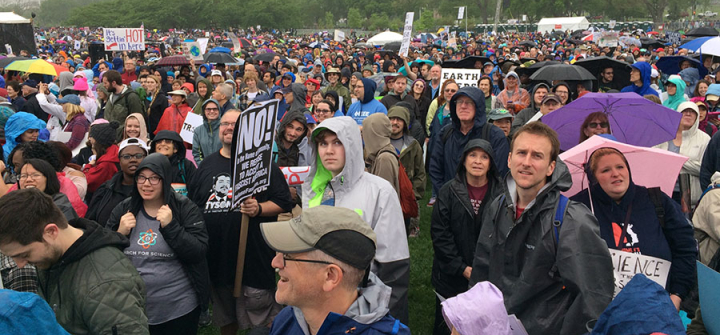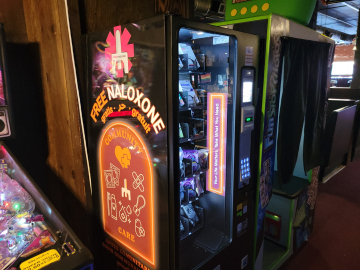Positively Drenched: The DC March for Science
WASHINGTON DC—Sometimes drizzling and sometimes pummeling, H2O couldn’t dampen the spirits of thousands of scientists and supporters who flocked to Washington DC for Saturday’s March for Science—one of 600 such events taking place worldwide.
For hours, they streamed through security checkpoints at the base of the Washington Monument. They came from Buffalo, small towns in Maine and Maryland, from Durham, North Carolina and points west. They wore lab coats. They sported crocheted pink “brain hats.” They brought their kids. They carried signs: “There is no Planet B,” “Remember Polio? Me Neither,” “I can march thanks to science >> new hip.” And even as the rain pelted them, they cheered a rock concert stage that included Bill Nye the Science Guy, musician Thomas Dolby (of the 1982 hit song “She Blinded Me with Science”), poet Jane Hershfield and others. For 4 hours they rooted, railed and rallied, and then they marched down Constitution Avenue to Capitol Hill. The lead protestors carried a 3-½ lane-wide “March for Science” banner.
Danielle Heath and husband Chris brought 2 of her 3 kids from their home near Washington DC. “I think that it is important they see the love for science, the support for science. It’s not just a nerdy thing anymore,” said Danielle Heath. “And they love Bill Nye, too.”
Her kids, Brayden and Addison, toted homemade signs (which included an angry beaker and an inspiring Barack Obama quote: “We are the change that we seek.”). She acknowledged the march might not make a difference nationally but was still glad they braved the weather. “Realistically, I can’t say I have much hope but I hope the rest of us who are not here will see how important it is and will get on board.”
Among the crowd mobbing the central stage, the sense of hope belied the weather. One emblematic sign read: “Think like a proton. Always positive.”
The encouraging vibe drew PhD student Tiffany Wilson from Duke University. “I just love the idea of being surrounded by so many scientists and like-minded people,” said Wilson, who is researching hydrology and water resources. “As a minority woman in the sciences, right now is a tough time in terms of identity attacks, and it’s important to bolster my sense of confidence and this seems to be a good way to do that.”
She hoped her presence (and maybe her sign “Got Plague? Yeah, me neither. Thank a scientist!“) might contribute to at least one person realizing that not all scientists are “part of a huge conspiracy.”
Her road trip buddy, Abigail LaBella, just defended her PhD in genetic and genomic research and carried a sign with a green cow and lab bench that read “The Scientific Method: You have NOT died of smallpox”). Earning her doctoral degree in an era when science seems to have been engulfed by the culture wars has made LaBella think it’s time for scientists to be more “visible” and to better translate their findings for the public. “I think scientists have been seen as outsiders, but we are just like everyone else,” she said. “I hope people will look at this and recognize the people here can be their friends and siblings.”
Wilson blames politicians for playing on people’s weaknesses and turning them against science. “What’s best for the environment or public health is not necessarily cheap. People are hesitant to invest in something when they don’t see an immediate threat. Humans are notoriously shortsighted, and a lot of these things are about the long game,” she said. “So, it’s a constant struggle.”
Prompted in large part by President Trump’s proposed cuts to the EPA, NIH and other science-based agencies, the march drew protestors who targeted the president’s approach to science, especially climate change research. “You can’t have a president who doesn’t believe in science. What is that?” said Susan Santangelo, a genetic epidemiologist at the Maine Medical Center Research Institute.
Across the field of umbrellas, ponchos and Gore-Tex challenged by occasional downpours, freelance science journalist Prachi Patel and her family listened to the main stage’s speakers, videos and music. She echoed one speaker’s call for scientists to talk with people about science and not at them. She also favored another’s statement about science’s essential role in keeping children healthy. Looking at her kids, she said, “They took their vitamins today. That was thanks to science, right?”
Then her son piped up: “Wait. I don’t remember taking my vitamins today.”
“Remember, I gave you vitamin C and you were gagging on it?” Patel responded.
“That was yesterday,” he said.
“Oh yeah, right,” Patel said.
With the vitamin debate settled, Patel said she the March for Science will “increase awareness in Congress and let them know it is not something to dismissed and taken lightly.”
As the rain came down harder, the bow-tied science star Bill Nye revved up the crowd and closed his talk with a resounding “Dare to save the world!” It elicited roaring approval from the crowd.
Those cheers, as well as intermittent music and speeches from 4 dozen speakers, carried the half mile to the White House, which was hosting its spring garden tour on Saturday. As visitors admired the tulips, hyacinths and foliage on the grounds, a military band played Dixieland jazz and other selections on the South Portico’s porch, drowning out the march’s booming protest.
Despite the downpours, thousands of scientists turned out in Washington DC for Saturday's March for Science. / Chloe Simpson





